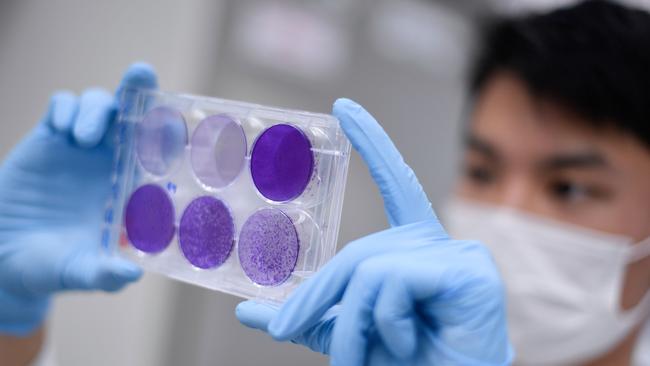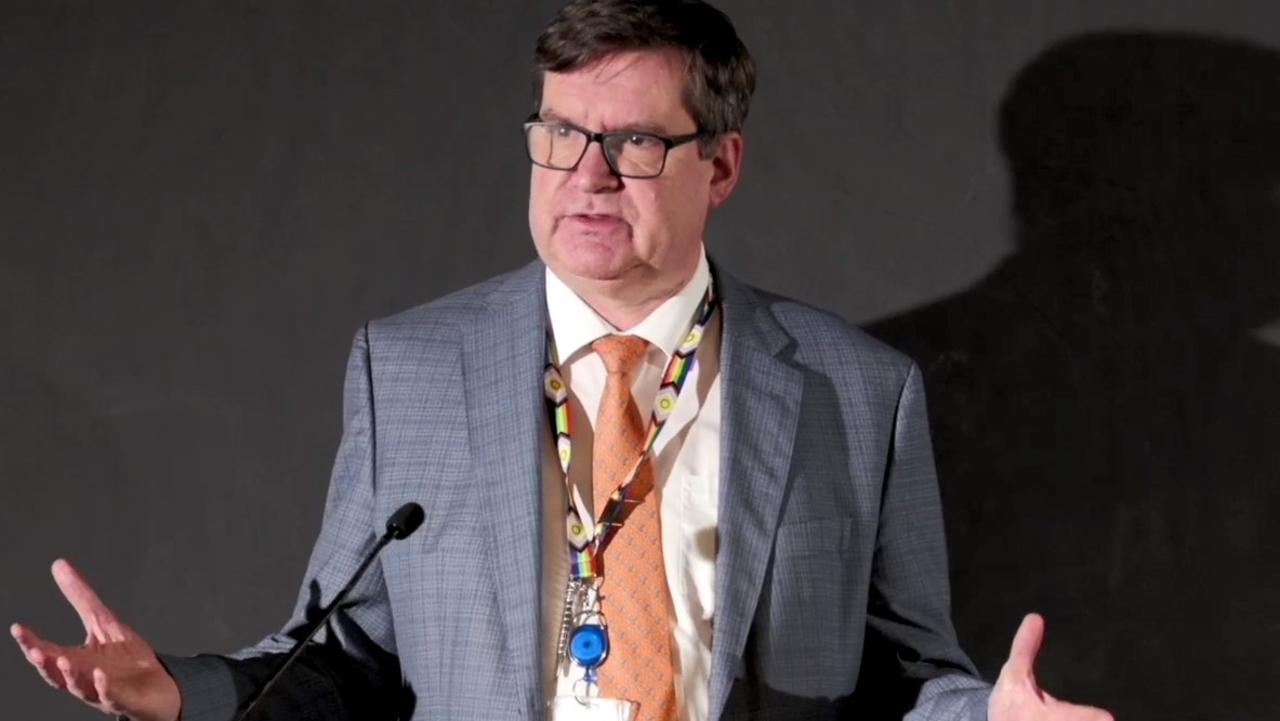Vaccine hopes grow but big hurdles exist outside the lab
Of the more than 140 different vaccine research programs taking place around the world, 23 are already in early-phase clinical trials, while Australia’s own project is a frontrunner in the global race. But should we be expecting a shot in the arm soon?

Coronavirus
Don't miss out on the headlines from Coronavirus. Followed categories will be added to My News.
There are strong grounds to hope a vaccine will be available by the end of the year, but nobody should be putting all their faith in getting a shot in the arm just yet.
Of the more than 140 different vaccine research programs taking place around the world, 23 are already in early-phase clinical trails.
The two most advanced — Moderna in the US and CanSino from China — will begin critical phase-three studies this month, when it will be known if they can halt COVID-19.
Australia’s own vaccine project led by the University of Queensland is also a frontrunner in the global race, with phase-one safety trials to begin on July 13.
The massive outbreaks in the US and Brazil where the phase three studies are to be conducted, means it should take only six to eight weeks to test the leading vaccine candidates in about 30,000 people, so the world may know by the end of August if they work.
If they do work, Doherty Institute director Professor Sharon Lewin said production and distribution challenges would have to be overcome, then there was genuine hope of a vaccine on the horizon.

“The best-case scenario is that we could have something by the end of 2020,” Prof Lewin said.
“But that would require everything to go perfectly.
“The chance of everything going to plan … I’d be guessing, but it might be a 50 per cent chance, given how many hurdles you have to jump through to get a vaccine to market“
Monash Health clinical sciences professor Jim Buttery said he was cautiously optimistic of a COVID-19 vaccine being produced by the end of this year.
“About 8 per cent of drugs and vaccines that get through to clinical trials end up being successful so I think it’s highly likely of the 140 starters, we’re going to have more than one successful candidate,” he said.
“The likely scenario is in a couple of years’ time we’ll have multiple vaccines and then it will be a question of availability and which ones work best in which populations and how long they protect for.”
Professor Peter Collignon of Australian National University medical school said there were some promising signs, but it would take at least 18 months to scale up production and distribution of a successful vaccine before it was widely available.
To be approved, a vaccine would have to show at least 80 per cent efficacy at stopping people getting the infection.
“That’s a big ask. You may well have to wait many months to get the results back. Then once you know your vaccine works, then you’ve got a manufacturing issue. You’ve got to have a large enough plant. We’re talking about billions of doses, you may need two or three doses per person,” Prof Collignon said.
Long before trials have been completed, commercialisation deals have already seen a billion doses of the vaccine from Oxford University in England produced so it can be quickly rolled out if successful.
Other teams are also setting up manufacturing in the hope of success, but Prof Lewin warns some types of vaccines can be mass-produced more quickly than others.
“Once you show a vaccine is safe and protected from infections, which could be done by September, the next challenge is to make it at scale, distribute it and implement it,” she said.
“There will be multiple vaccines, no doubt. We need more than one vaccine for both for access and manufacturing.
“Different countries will have different vaccines, some vaccines will work better in some populations, high-risk groups such as the elderly may need a different vaccine, as may children.”

The fact the University of Queensland research is a protein vaccine — one of the most common and easy to produce — gives it a distinct advantage.
CSL is already in place to produce the shot if it is proved effective, with a trial to be overseen by the Doherty Institute.
Like most other nations and research teams, the Australians have promised to share doses with the rest of the world if successful.
Global initiatives led by the World Health Organisation, the global alliance on vaccines, and a European alliance are among those pledging to share any successful vaccines with poorer nations so the pandemic can be stamped out.
However, the US and commercialisation may present a hurdle no scientist can overcome.
Queensland University of Technology’s Professor Matthew Rimmer is echoing widely held concerns the US will take an “America First” approach to breakthroughs.
“This stance would go against the global tide of co-operation and collaboration of countries, institutions, companies and international organisations,” he said.
While the Medicines Patent Pool has expanded its mandate to cover COVID-19 technologies, some pharmaceutical companies are unwilling to join the voluntary initiative.
Beside vaccines, a number of drugs have indicated effectiveness against COVID-19, but Prof Buttery warns “none of those is a magic bullet”.
“I think most people think a really good drug is going to potentially save some lives, but the fact is that it won’t cure everyone,” he said.
Prof Lewin warns the combined hurdles of production, distribution and commercialisation would still mean Australians may be waiting a long time for true relief from the coronavirus.
“In the meantime, the only thing we know that works is physical distancing, rapid diagnosis, isolation and quarantine,” Prof Lewin said.
“We are going to have to live with that for a long time. It will be at least 12 to 18 months that we are going to have that around.”

VACCINE HOPES
MODERNA
The Boston-based biotechnology company plans to begin Phase III trials in 30,000 US volunteers this month, where some subjects will be given the vaccine being tested while others receive a placebo to see how effective it is in the real world. If successful the company hopes to have doses ready in early 2021.
CANSINO
The Chinese company is set to begin Phase III clinical trials of its Ad5-nCoV vaccine in 40,000 volunteers in the coming weeks, after becoming the first team in the world to publish a full scientific study on its early human trials.
OXFORD UNIVERSITY
One of the first coronavirus research programs to begin adapting a MERS vaccine for COVID-19, it was the third to enter the first phases of human trials. It has now recruited more than 10,000 people for a Phase III trial and, backed by AstraZeneca, has already began mass production in the hope of success and development by October.
SINOVAC
One of seven Chinese teams pushing for a coronavirus vaccine, will begin a Phase III study in Brazil this month, enrolling 9000 volunteers.
UNIVERSITY OF QUEENSLAND
The first of 120 Brisbane volunteers will receive the S-clamp vaccine candidate on July 13 under an early stage trial primarily aimed at ensuring it is safe, ahead of bigger studies to test effectiveness planned for the coming months.
TREATMENT HOPES
DEXAMETHASONE
A UK government-funded trial found it reduced the risk of death in COVID-19 patients on ventilation by as much as 35 per cent and patients on oxygen by 20 per cent, reducing the total 28-day mortality rate by 17 per cent.
REMDESIVIR
Previously used to fight ebola, with trials showing it aided with quicker recovery times for coronavirus. The US said it had more than 500,000 treatment courses of the drug, or 90 per cent of its expected production for August and September.
MORE NEWS
BUREAUCRATS AXED FROM HOTEL QUARANTINE TASK FORCE
LOW TESTING UPTAKE IN VIRUS HOTSPOTS


